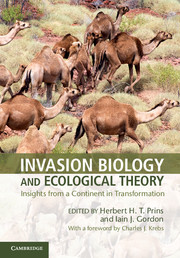Book contents
- Frontmatter
- Contents
- List of Contributors
- Foreword
- 1 Testing hypotheses about biological invasions and Charles Darwin’s two-creators rumination
- Part I Ancient invaders
- Part II Modern invaders
- 13 Invasion by woody shrubs and trees
- 14 Modern tree colonisers from Australia into the rest of the world
- 15 Failed introductions: finches from outside Australia
- 16 The skylark
- 17 Why northern hemisphere waders did not colonise the south
- 18 Weak migratory interchange by birds between Australia and Asia
- 19 Introducing a new top predator, the dingo
- 20 The European rabbit
- 21 The rise and fall of the Asian water buffalo in the monsoonal tropics of northern Australia
- 22 A critique of ecological theory and a salute to natural history
- Index
- References
16 - The skylark
from Part II - Modern invaders
Published online by Cambridge University Press: 05 February 2014
- Frontmatter
- Contents
- List of Contributors
- Foreword
- 1 Testing hypotheses about biological invasions and Charles Darwin’s two-creators rumination
- Part I Ancient invaders
- Part II Modern invaders
- 13 Invasion by woody shrubs and trees
- 14 Modern tree colonisers from Australia into the rest of the world
- 15 Failed introductions: finches from outside Australia
- 16 The skylark
- 17 Why northern hemisphere waders did not colonise the south
- 18 Weak migratory interchange by birds between Australia and Asia
- 19 Introducing a new top predator, the dingo
- 20 The European rabbit
- 21 The rise and fall of the Asian water buffalo in the monsoonal tropics of northern Australia
- 22 A critique of ecological theory and a salute to natural history
- Index
- References
Summary
Introduction
The Eurasian skylark (Alauda arvensis Linnaeus) is a small passerine that breeds across most of Eurasia from Western Europe and northwest Africa to eastern Russia, northern China, Japan and eastern Siberia (Figure 16.1). Its taxonomy is somewhat murky, A. arvensis is sometimes considered forming a superspecies with the Oriental skylark (A. gulgula Franklin) and some of its 13 subspecies are treated as species by some authors (del Hoyo et al. 2004). The subspecies are sometimes divided into ‘European Group’ and ‘Asian Group’, which I refer to as western and eastern skylarks in the remainder of this chapter. The western skylark (especially the subspecies A. a. arvensis) was the subject of most published studies as well as providing stock for introductions. Skylarks are mainly resident in the west of their range, but eastern populations are more migratory, moving further south in winter (Figure 16.1).
In the past, especially through the nineteenth century, the skylark’s range had presumably expanded, as large-scale habitat change, including increased deforestation and expansion of crops and pastures made it possible for the species to spread from diminishing natural steppe grasslands (Cramp 1988). Today it is one of the most common farmland birds in countries with extensive farmland, such as Germany (Toepfer and Stubbe 2001), France (Eraud and Boutin 2002), the Netherlands (Kragten et al. 2008), Sweden (Wretenberg et al. 2006), Finland (Suhonen et al. 1994), Poland (Sanderson et al. 2009) and the United Kingdom, where about 70% of the total skylark population occurs on farmland and 50% on arable land (Donald and Vickery 2000).
- Type
- Chapter
- Information
- Invasion Biology and Ecological TheoryInsights from a Continent in Transformation, pp. 351 - 372Publisher: Cambridge University PressPrint publication year: 2014

